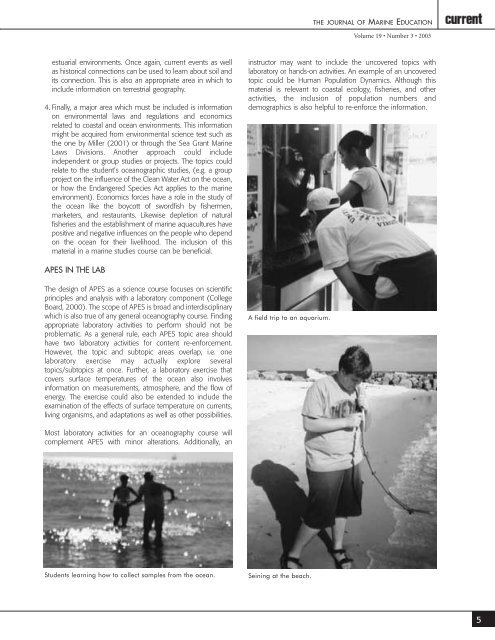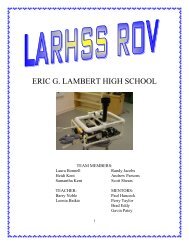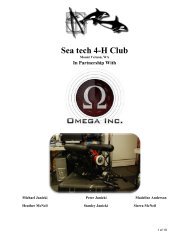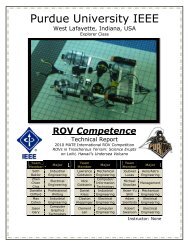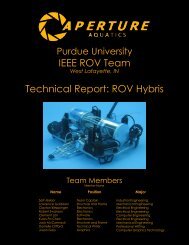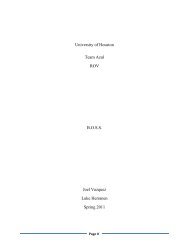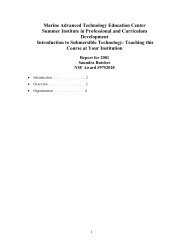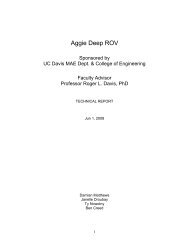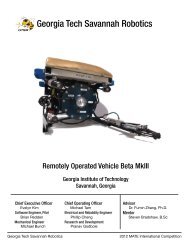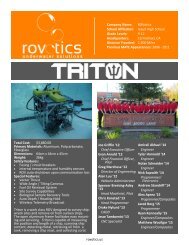Volume 19 • Number 3 • 2003 - the Marine Advanced Technology ...
Volume 19 • Number 3 • 2003 - the Marine Advanced Technology ...
Volume 19 • Number 3 • 2003 - the Marine Advanced Technology ...
You also want an ePaper? Increase the reach of your titles
YUMPU automatically turns print PDFs into web optimized ePapers that Google loves.
THE JOURNAL OF MARINE EDUCATION<br />
<strong>Volume</strong> <strong>19</strong> <strong>•</strong> <strong>Number</strong> 3 <strong>•</strong> <strong>2003</strong><br />
estuarial environments. Once again, current events as well<br />
as historical connections can be used to learn about soil and<br />
its connection. This is also an appropriate area in which to<br />
include information on terrestrial geography.<br />
4. Finally, a major area which must be included is information<br />
on environmental laws and regulations and economics<br />
related to coastal and ocean environments. This information<br />
might be acquired from environmental science text such as<br />
<strong>the</strong> one by Miller (2001) or through <strong>the</strong> Sea Grant <strong>Marine</strong><br />
Laws Divisions. Ano<strong>the</strong>r approach could include<br />
independent or group studies or projects. The topics could<br />
relate to <strong>the</strong> student’s oceanographic studies, (e.g. a group<br />
project on <strong>the</strong> influence of <strong>the</strong> Clean Water Act on <strong>the</strong> ocean,<br />
or how <strong>the</strong> Endangered Species Act applies to <strong>the</strong> marine<br />
environment). Economics forces have a role in <strong>the</strong> study of<br />
<strong>the</strong> ocean like <strong>the</strong> boycott of swordfish by fishermen,<br />
marketers, and restaurants. Likewise depletion of natural<br />
fisheries and <strong>the</strong> establishment of marine aquacultures have<br />
positive and negative influences on <strong>the</strong> people who depend<br />
on <strong>the</strong> ocean for <strong>the</strong>ir livelihood. The inclusion of this<br />
material in a marine studies course can be beneficial.<br />
instructor may want to include <strong>the</strong> uncovered topics with<br />
laboratory or hands-on activities. An example of an uncovered<br />
topic could be Human Population Dynamics. Although this<br />
material is relevant to coastal ecology, fisheries, and o<strong>the</strong>r<br />
activities, <strong>the</strong> inclusion of population numbers and<br />
demographics is also helpful to re-enforce <strong>the</strong> information.<br />
APES IN THE LAB<br />
The design of APES as a science course focuses on scientific<br />
principles and analysis with a laboratory component (College<br />
Board, 2000). The scope of APES is broad and interdisciplinary<br />
which is also true of any general oceanography course. Finding<br />
appropriate laboratory activities to perform should not be<br />
problematic. As a general rule, each APES topic area should<br />
have two laboratory activities for content re-enforcement.<br />
However, <strong>the</strong> topic and subtopic areas overlap, i.e. one<br />
laboratory exercise may actually explore several<br />
topics/subtopics at once. Fur<strong>the</strong>r, a laboratory exercise that<br />
covers surface temperatures of <strong>the</strong> ocean also involves<br />
information on measurements, atmosphere, and <strong>the</strong> flow of<br />
energy. The exercise could also be extended to include <strong>the</strong><br />
examination of <strong>the</strong> effects of surface temperature on currents,<br />
living organisms, and adaptations as well as o<strong>the</strong>r possibilities.<br />
A field trip to an aquarium.<br />
Most laboratory activities for an oceanography course will<br />
complement APES with minor alterations. Additionally, an<br />
Students learning how to collect samples from <strong>the</strong> ocean.<br />
Seining at <strong>the</strong> beach.<br />
5


